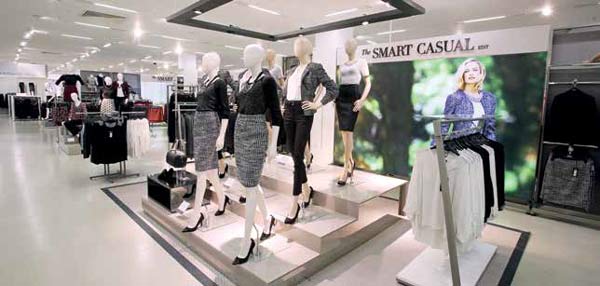The new old
Marks & Spencer has become one of those brands that journalists can’t mention without inserting the adjective “beleaguered”. In its first-quarter 2017 trading update, M&S undershot already-low expectations for its clothing and homeware division, reporting a 6% slump in sales against analysts’ forecast of half that.
Fashion is the thing it can’t get right – despite burning through creative directors and celebrity endorsers, and promising to turn the corner in every annual report since 2013.
A look around the stores this spring imparts the feeling of a business both falling back on steady formulas and trying too hard to be bold. Over here are some solid orange wide-leg slacks that will announce your presence from the far end of the street. Over there is a long, flowing dress with top-to-bottom stripes that will turn you into a walking barber’s pole. Floral frocks – it’s got ’em. You might not want them, but it’s got them.
Upstairs, there are 25 ways to be chino-man, most of them harmless but none of them provoking a queue or any noticeable signs of enthusiasm. Muted, too, is the suits section, which manages neither to break new ground nor earn the epithet “classic”.
Looking down on proceedings is a giant David Gandy in his underpants, titillating the women and reminding the men that they really ought to be fitter – and younger.
But they’re not. M&S needs to make peace with the fact that its core customer for fashion is over 50 years old – and then try to find new ways of seeing and understanding this protean cohort and figuring out where they are going with their lives.
An unlikely source of inspiration could be a report published last month by the World Economic Forum: We’ll Live to 100: How Can We Afford It?. The think-tank makes it clear that people will need to keep working beyond current retirement milestones before dipping into their pensions.
In its matter-of-fact way, the WEF paints a picture of people in their fifties, sixties and beyond not as over the hill but as economically active societal assets. It is a theme endorsed in recent statistics that show the over-fifties are behind more business starts-ups than any other age group.
In absolute terms, the numbers of the dynamic, working old are small – only one in ten currently stays in work beyond 65 – but it is undoubtedly the direction of travel. M&S has the clout to answer the big question posed by this burgeoning social phenomenon. Not “Where will they work?” or “Who will employ them?” – they’ll figure that out – but “What will they wear?”. They’ll need to look and feel good as they extend their careers. They’ll need to project a sense of dynamism in interviews.
 Of course, if they happen to be working from home, as many of them will, you could argue that they can wear whatever they like. Who will know if they’ve slipped on a baggy, off-white T-shirt and holed jogging bottoms?
Of course, if they happen to be working from home, as many of them will, you could argue that they can wear whatever they like. Who will know if they’ve slipped on a baggy, off-white T-shirt and holed jogging bottoms?
Well, they will. Clothes affect performance, even if there’s only one person in the room. A new-business email will be more crisply written, a new-client call more assertive, if the person feels good about what they’re sitting down – or preferably standing up – in.
M&S, in its crazily sprawling range, already does loungewear, daywear, partywear, workwear, sportswear, beachwear and more. It needs to cull some of those and invent and focus on a new clothing category: purposewear.
This will be style for people whose sense of purpose is even greater in the second half of their lives than in the first. Simple, cool, lean-forward fashion with sharp lines and well-judged details. Modern fabrics. Shorter runs. Not traditional work stuff – the kind of thing you want out of the minute work ends – but not that sartorial oxymoron of smart-casual either. And no orange, thank you.
Purposewear will give back M&S its own sense of purpose. It will show the over-fifties that there is at least one brand that understands their innate dynamism and drive. It will acknowledge no age cut-off in economic or social agency, and will ask David Gandy to step aside in favour of stunning, 70-year-old models, in the way that Dove achieved in its campaign for real beauty.
M&S cannot stay beleaguered forever. Some already predict the gradual phasing out of fashion to concentrate on its more profitable food division. But fashion is in its blood. “Purposewear” is a counter-intuitive way to put some new blood into its fashion.
In its May 2017 report, the Geneva based foundation warned of a “global pension time bomb” because people are living much longer.
It showed that when pension systems were designed, people could typically expect to live and pick up payments for five to eight years beyond retirement age. With today’s life expectancies, they could receive payments for a further 11 to 16 years beyond that.
The six largest pension saving systems – the US, the UK, Japan, the Netherlands, Canada and Australia – are expected reach a $224tn funding gap by 2050.
The World Economic Forum’s principal policy recommendation was to review retirement age – raising it to 70 in leading developed countries.
